On side b we can find Rijl al Awwa at a more
understandable glyph:
|
'October 1 |
2 |
3 |
4 (277) |
|
October 28 |
29 |
30 |
31 (304) |
 |
 |
 |
 |
|
Cb8-24 |
Cb8-25 |
Cb8-26 |
Cb8-27 (590) |
| te
maitaki |
kua hua
te kahi |
te ahine poo puo |
ki te
huaga |
|
ρ Lupi
(221.0), Toliman (221.2), π Bootis (221.8), ζ Bootis
(221.9) |
31 Bootis
(222.0), Yang Mun (222.1),
Rijl al Awwa
(222.5), ο
Bootis (222.9) |
Izar
(223.0), 109 Virginis, α Apodis (223.3) |
Al
Zubānā-14a /
Visakha-16 /
Root-3 |
|
ZUBEN
ELGENUBI
(224.2), ξ Bootis, ο Lupi (224.5) |
|
ν Arietis (38.5) |
μ Arietis (39.4),
Head of the Fly (39.6),
Kaffaljidhma (39.8) |
ο Arietis (40.0), Angetenar
(40.2), Right Wing (40.9) |
Bharani-2 /
Stomach-17 |
|
π Arietis (41.2),
BHARANI (41.4), τ² Eridan,
σ Arietis (41.7) |
In Ca8-26 a 'roof' covers henua,
appropriate for the arrival of dark autumn when the spring side
of the sky was visible in the night sky.
Rijl al
Awwa was not a first point but a last point. This we can
understand by contemplating the figure in Cb8-26. From the last
point of Andromeda (Alamak, γ, 29.7)
to the last point in Virgo (Rijl al Awwa,
μ, 222.5) there were 193
days.
Metoro said te ahine poo puo and the
woman (ahine) ought here to refer to Virgo. As to the
peculiar poo puo we have investigated the expression earlier:
... Colours
are not visible in the night and below I
have therefore not used them on the back
side:
|
back side |
 |
 |
 |
 |
|
Eb7-1 |
Eb7-2 |
Eb7-3 |
Eb7-4 |
|
front side |
 |
 |
 |
 |
 |
 |
 |
|
Eb7-5 |
Eb7-6 |
Eb7-7 |
Eb7-8 |
Eb7-9 |
Eb7-10 |
Eb7-11 |
|
back side |
 |
 |
 |
|
Eb7-12 |
Eb7-13 |
Eb7-14 |
Our more
familiar 'week' from Sunday in Eb7-5 onwards
will end with Saturn, and then the empty
hand of tagata rere in Eb7-12 repeats
the gesture of the empty hand of Rogo
in Eb7-1. But the position is very different
- high up instead of low down. In Eb7-11 the
'stem' has its 'crown' very high from the
ground level, in contrast to the situation
in Eb7-9.
This great
'fortnight' has the colourful season of Sun
in its center. The beginning is with the Mad
Hatter in Eb7-1, where Metoro said te
tagata puo pouo. He evidently commented
on how the 'head' of Spring Sun (in form of
Mars) had been covered up (pu'o):
|
Pu'o
(Also pu'a);
pu'o nua, one who covers
himself with a nua
(blanket), that is to say, a
human being.
1. To dress,
to clothe, to dress the hair;
puoa, clothed; puoa
tahaga, always dressed. 2.
To daub, to besmear (cf. pua
2); puo ei oone, to daub
with dirt, to smear. 3. Ata
puo, to hill up a plant. |
Pouo
seems to have been some kind of hairdo for
women:
'... Metoro
erklärt mehrere Vorkommen auf der Tafel
Tahua mit ahine poopouo, und
Jaussen übersetzt in seiner Liste vie
poko pouo als femme coiffée ...
Tatsächlich trugen auf der Osterinsel die
Frauen tief in den Nacken fallendes Haar
...' (Grundlagen zur Entzifferung der
Osterinselschrift.)
|
Poko
1. Fragrant;
to smell, to give off a smell:
he-poko te eo, it gives
off a pleasant smell. 2. To
hunt, to catch with a trap, to
snare. He-kî e Tori: maaku-á
e-ea ki te manu, e-poko i te po
i ruga i te opata. Tori
said: I shall go and catch birds
at night, up on the cliff. 3.
Thunder (also hatutiri).
4. (Also: pokopoko.)
Hollow, hole, depression, any
deep, concave object; to leave
in a hole, in a depression.
Pokoga, chasm; summit.
Pokohata, female rat:
kio'e pokohata. Pokopoko,
woman bent under the weight
of her years: vî'e pokopoko.
1. Sound of
the sea; tai poko,
breakers. Pokopoko, to
slap water. Mgv.: pokokina,
resonant, clear-toned. Mq.:
poko, to slap the water in
imitation of drumming;
pokokina, sound of water. 2.
Rut, beaten path. P Pau.:
poko, hollow; pokopoko,
concave, to excavate. Mgv.:
poko, to dig, to excavate,
to hollow out. Mq.: pokoko,
to crack open; pokona, to
hollow out, to excavate. Ta.:
poópoó, hollow, deep. 3.
Infernal; pokoga, hell,
infernal cave; topa ki te
pokoga, to damn (lit: to go
down to hell.) Mq.: pokona,
cavity, hole.
Pokopoko:
1. Womb. PS Sa.: po'opo'o,
clitoris. Mq.: pokopoko,
pudendum muliebre. 2.
Pokopoko vae,
footprints. 3. Concave, deep,
ditch, mysterious; pokopoko
ihu, nostril (Ta.:
poópoó ihu);
pokopoko ke,
fathomless; pokopoko
taheta, concave.
Hakapokopoko, to deepen. |
Mercury is a
female character, the very opposite to the
preceding fierce warrior Mars.
|
In the Babylonian zodiac Mercury dwells between
a pair of earth women (Furrow and Frond) who were following Lion
respectively Raven:



You
cannot stand up in a canoe.
|






